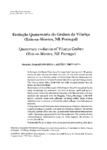Evolução Quaternária do Graben de Vilariça (Trás-os-Montes, NE Portugal)

Ver/Abrir
Use este enlace para citar
http://hdl.handle.net/2183/6191Colecciones
Metadatos
Mostrar el registro completo del ítemTítulo
Evolução Quaternária do Graben de Vilariça (Trás-os-Montes, NE Portugal)Título(s) alternativo(s)
Quaternary evolution of Vilaric.;a Graben (Trás-os-Montes, NE Portugal)Fecha
1995Cita bibliográfica
Cadernos do Laboratorio Xeolóxico de Laxe, 1995, 20: 123-137 ISSN: 0213-4497
Resumen
[Abstract] In Portugal, the Douro River has a first large bend, leaving it's E-W general orientation after the Spanish border and near the Coa River mouth; another infiection occurs in Pocinho, where the Douro River fills the Vilari\a tectonic depression and receives the water from the Sabor River and the Vilari\a stream. The Vilari\a stream fills a NNE-SSW fiat valley situated between Serra de Bornes and the Sabor River. Quaternary evolution of this sector of the Hesperic Massif is recognized by the valley morphology and sediments, the Serra de Bornes' uplift and tectonic displacement (horizontal and vertical) ofgranites and Paleozoic series. All these evidences are associated with the Bragan\a-Vilari\a-Manteigas NNE-SSW tectonic accident, where more sediments are being studied. Many of these sediments have in common an alluvial fan origin and ages since Paleogene are proposed.
Vilari\adepositsand Pleistocene Douro terraces present identical characteristics
in geomorphological position and sorne sedimentologic features like reddish
color and kaolinite-illite-smectite clay association; these similar characteristics
justify a Quaternary age proposal for the Vilari\adeposits. The variation ofother
sedimentological characteristics along the valley suggests the presence of
several alluvial fans.
Palabras clave
Tectonic
Quaternary
Sedimentary deposits
Terraces
Alluvial fans
Quaternary
Sedimentary deposits
Terraces
Alluvial fans
ISSN
0213-4497





